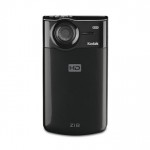What Equipment Do I Need for Online Video?
Posted on Jun 26, 2011 in Internet Business, Tech Tips & Tricks, Video | 1 comment
When you think of video, you may find yourself thinking of massive cameras that cost more than a new car and weight almost as much as you do, big boom mikes swung overhead in a brightly lit studio.
With every year that passes, however, video solutions are getting smaller and more affordable. The typical small business uses digital video recorders smaller than the hand of the person holding it.
Video Basics
Resolution
Find out how many megapixels your device has. This may be specified as “3 MP” or “8 Megapixels,” for example. More is better and results in a higher-quality picture. This is constantly improving, so just use this to compare devices to each other, or look at the results and see what seems to be acceptable quality.
Microphones
Audio is a big issue. Most devices that record video have only the most basic microphones; even if the video looks great, the audio quality can suffer. Find out what your options are for connecting other microphones; with a webcam, for example, you can hook up many excellent microphones to the computer and use them for the audio portion. Smartphones typically don’t have much in the way of options for additional microphones–just anything that plugs into a standard audio input jack, digital cameras often only allow their tiny, tinny built-in microphone, but digital video recorders should allow professional microphones.
- condenser microphones are a particular kind of microphone. The difference is technical and not too important for you to know, but they are quite popular and usually are high-quality.
- lavalier microphones (pronounced “lavv-uh-leer”) are also called lapel mics. They are small microphones that clip to your clothes near your throat, typically powered by a small belt pack. They are ideal for most situations, as you can move around while using them, but even if you are stationary they are less obtrusive on the video.
Lighting
In photography and video, attention to lighting is essential. Lighting can make all the difference in the world between whether something looks amateurish or professional. If you are moving from room to room in the video or if the video is outside, it may not be worth the effort; otherwise, special effort should be paid to keep the recording area brightly lit. A clean, light-colored room and a lighting kit can be very useful.
Tripods
A video that shivers or tilts looks very unprofessional. If you’re moving a lot–doing a video walkthrough of a property for sale, for example—then it’s not too much of a concern. If you’re recording something more stationary, it’s very important for the camera to be stable. In some cases you may just rest it on top of a stationary object. There are many small tripods that can be mounted on a tabletop, like this one or this one. If you’re serious about taking video on a regular basis you should invest in a full-size tripod.
The Simplest Video Solution
Have a smartphone? A webcam? A digital camera? Odds are that any of those can work for you.
Most modern cell phones have a camera for taking pictures and video. (Note: if you still have the iPhone 3G, which does not allow video recording, you can use the Ustream iPhone app to record video.) Note that if you want to use a smartphone on a tripod, you will likely need a smartphone tripod adapter.
You can find special software to record video with a webcam, or you can record straight to YouTube from a webcam.
Most digital cameras have an option for recording in video as well.
The problem with these solutions is that the quality simply may not be sufficient… but it may be enough to get started, especially for someone self-employed, or if you’re not sure that you want to put a lot of time and effort into video on a regular basis.
Professional but Affordable Video Solution
Traffic Geyser has an excellent video on making an affordable video studio for around $400. Their recommendations are:
- Kodak Zi8 Video Camera
- Audio Technica Lavalier Mic
- Manfrotto tripod 785b (or just about any full-sized tripod, like this one)
- Lighting kits
For a small business wanting to make attractive videos, it’s easy enough to get some basics for a few hundred dollars and is a sound investment.





Your article What Equipment Do I Need for Online Video? | Alamoxie write very well, thank you share!